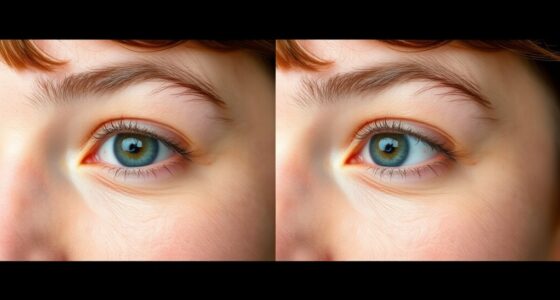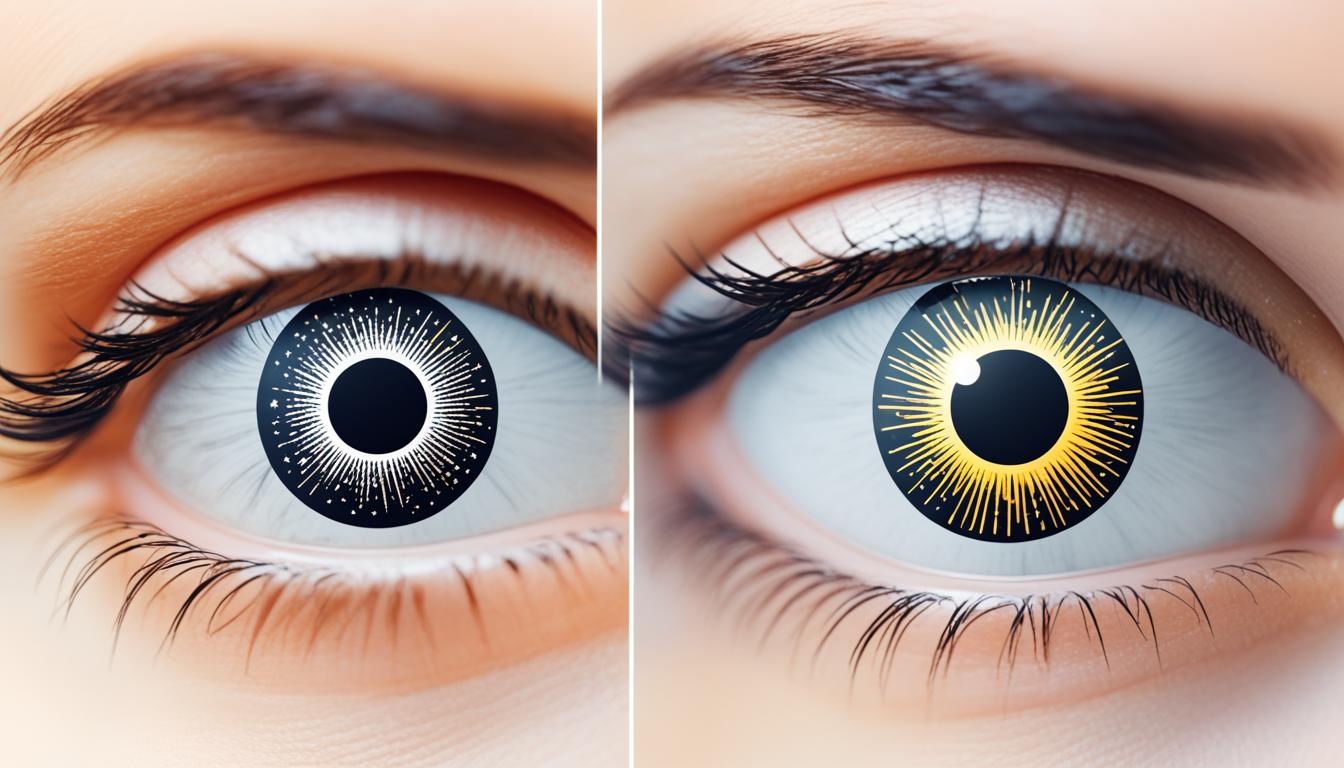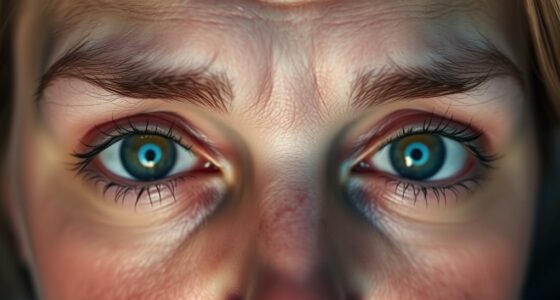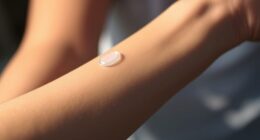Eye patches have come a long way from their pirate roots to essential medical tools. You’ll find adhesive patches for quick treatment, cloth patches that’re eco-friendly and reusable, and luxurious silk patches that blend style with function. Lens cover patches offer a non-adhesive option, while eye shields are great for post-surgery care. Each type serves unique purposes, catering to different needs. Stick around to discover the historical significance and the best choice for your requirements.
Key Takeaways
- Eye patches evolved from military and medieval uses to become iconic symbols in pirate lore, though many myths are fictional.
- Various materials are used for eye patches, including adhesive, cloth, silk, and lens cover options, each serving different purposes.
- Medical applications of eye patches include treating amblyopia, protecting corneal abrasions, and aiding recovery post-surgery.
- Choosing the right eye patch depends on factors like age, skin type, and specific eye conditions to ensure comfort and effectiveness.
- Hygiene and material breathability are crucial for safety, especially for children and post-surgical care, enhancing overall comfort during use.
The Evolution of Eye Patches: From Pirates to Patients

While many associate eye patches with the swashbuckling pirates of yore, their history stretches far beyond the high seas.
In ancient times, soldiers wore them to shield their eyes from blinding sunlight during battles. Knights in the Middle Ages used visors for protection during jousting. The pirate era cemented the eye patch’s fame, as it was thought to help with night vision. By the 16th century, French surgeon Ambroise Paré began using eye patches to treat injuries. Today, you’ll find eye patches used for medical purposes, such as protecting injured eyes, treating amblyopia, and aiding recovery after surgeries, as they are also effective for treating corneal abrasions and eye infections.
This evolution demonstrates how a simple accessory transformed from a tool of combat to an essential medical aid.
Understanding Adhesive Patches: Quick and Convenient

Adhesive patches, made from soft materials like foam or cloth, stick directly onto the skin around your eye. They’re quick to apply and provide a secure fit, making them perfect for short-term use. Lightweight and portable, you can easily carry them wherever you go.
These patches are ideal for treating conditions like amblyopia or protecting your eye after surgery. Additionally, using essential oils like lavender oil can help alleviate stress during the healing process. However, be cautious of potential skin irritation or allergic reactions from the adhesive. Always verify the area is clean before application and consult a healthcare professional if you have concerns. Additionally, it’s important to consider the potential side effects of any adhesive materials used in these patches.
Exploring Cloth Patches: Reusable and Comfortable

Cloth patches offer a comfortable and eco-friendly alternative for eye protection and vision therapy, making them a popular choice among users. Made from soft fabric, they provide a gentle feel against the skin, reducing irritation. Since they’re reusable and washable, you can save money while minimizing waste. The adjustable fit, often achieved with a string or elastic, guarantees they stay secure without sticking to your skin. Ideal for protecting the eye after surgery or injury, these patches prevent dust and debris from entering. Plus, their breathability allows for airflow, keeping you comfortable during recovery. Cloth patches are also beneficial for treating lazy eye by promoting the use of the weaker eye. Additionally, using these patches can help reduce the risk of financial scams associated with purchasing ineffective eye care products. Moreover, the health benefits of cloth patches include comfort and reduced irritation, which enhances the overall recovery experience. Whether for adults or children, cloth patches combine practicality and comfort, making them an excellent option for anyone in need of eye protection.
The Allure of Silk Patches: Fashion Meets Function

When it comes to eye patches, silk offers a unique blend of style and practicality that sets it apart from other options. The smoothness and breathability of silk make it a comfortable choice, especially for those with sensitive skin. Its hypoallergenic properties reduce irritation and inflammation, while its natural antimicrobial benefits help prevent bacterial transfer, keeping your skin clear. Plus, silk’s moisture management capabilities maintain hydration without feeling damp, ensuring your skin stays plump. Additionally, innovative silk patches can calm irritation and nurture the sensitive eye area, enhancing their effectiveness. Furthermore, using silk patches can reduce reliance on harsh chemicals in your skincare routine, promoting a more natural approach to eye care. In fact, silk’s unique properties are often recommended for highlighted hair care, ensuring that it not only serves aesthetic purposes but also contributes to overall skin and hair health. Aesthetically, silk patches are simply beautiful, adding a touch of elegance to your eye care routine. Whether you’re using them for fashion or function, silk patches prove that style and effectiveness can go hand in hand, making them a must-have accessory.
Lens Cover Patches: A Non-Adhesive Solution

For those seeking a practical and comfortable way to block vision from one eye, lens cover patches offer an excellent non-adhesive solution.
These patches fit directly over your glasses’ lenses, ensuring the affected eye is completely obstructed. Made from soft, lightweight materials, they provide a comfortable fit without irritation. Eyepatches were used for dark adaptation in historical contexts, allowing pirates to navigate between bright and dark areas more effectively. In addition, many users have reported feelings of emotional significance when using these patches, as they can evoke memories associated with past experiences. Regular maintenance of these patches can enhance their durability and effectiveness, making them a cost-effective choice for users. Moreover, they can help reduce dark circles and puffiness under the eyes, adding to their appeal.
You’ll find them easy to use—just place them on your glasses whenever needed. Plus, their reusable nature makes them cost-effective, saving you money in the long run.
With options available for universal and customizable fits, they adapt to various eyewear styles. Unlike adhesive patches, lens covers are easier to manage, offering you convenience without compromising comfort.
They’re a fantastic choice for treating conditions like amblyopia and strabismus.
Eye Shields and Pads: Post-Surgery Essential
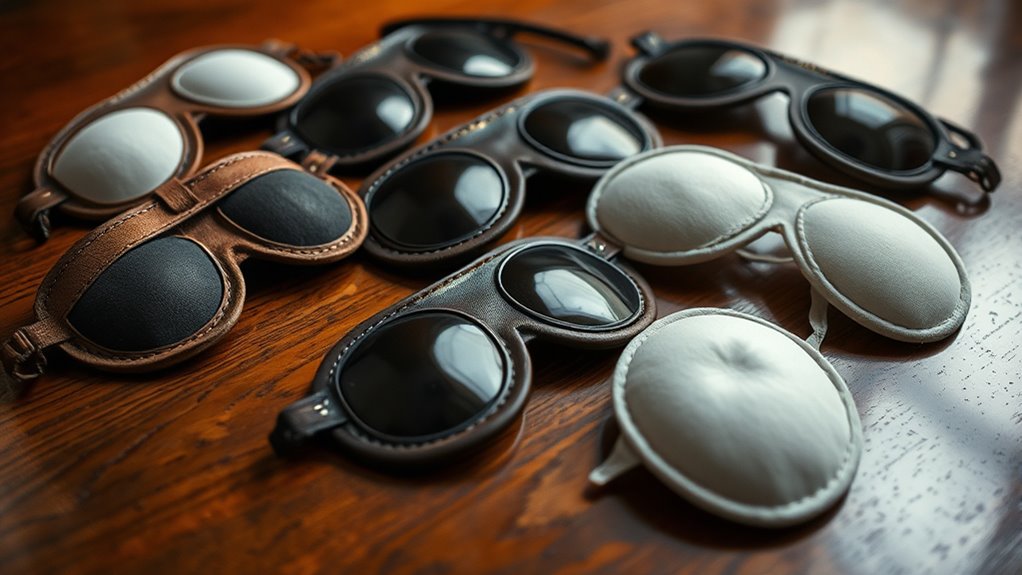
Eye shields and pads are essential for protecting your eyes after surgery, ensuring a smooth recovery. They prevent accidental rubbing or pressure, which is vital following procedures like cataract surgery. Typically, you’ll need to wear these shields for at least a week to avoid complications. Eye shields are required during sleep, including night and naps, to prevent damage to the eye during healing.
Eye shields are crucial for post-surgery recovery, preventing accidental pressure and promoting healing after procedures like cataract surgery.
Designed with small perforations, they let in light while blocking dust and contaminants, reducing infection risk. Options like the Duo Shield provide comfort and affordability.
For added soothing, consider using eye pads or gels, especially cryotherapy pads to reduce swelling. Always follow your post-operative care instructions, and don’t hesitate to consult your healthcare provider if you experience discomfort.
Prioritizing this care is key to a successful recovery.
Medical Applications: Treating Common Eye Conditions

After surgery, eye shields and pads play an important role in protecting your eyes, but they’re not the only way to address eye health.
Eye patches serve multiple medical applications, particularly in treating common eye conditions. For amblyopia, covering the stronger eye helps improve vision in the weaker one. If you experience double vision, patches can block one eye to help your brain focus on a single image. They also assist in healing corneal abrasions by protecting the affected area. Additionally, if you deal with light sensitivity, patches can provide much-needed relief. Eye patches can also be used post-surgery to prevent damage from rubbing or exposure to bright light.
These noninvasive solutions can promote healing and improve vision quality, making them essential tools in eye care. Always follow medical advice for best results.
Historical Significance: Eye Patches in Pirate Lore

While many people associate eye patches with pirates, the historical reality is far more nuanced than popular culture suggests.
The idea that pirates wore eye patches for tactical advantages or to enhance vision is a myth lacking historical evidence. These depictions largely stem from literary works like “Treasure Island,” which shaped our cultural perception. In fact, the lack of evidence supporting the use of eye patches by pirates indicates that such imagery is primarily a creation of fiction rather than fact.
Eye patches were likely worn for aesthetic reasons or to cover injuries, similar to other sailors. Common eye injuries occurred at sea, but wearing patches wasn’t unique to pirates.
Despite the lack of historical accuracy, the eye patch remains an iconic symbol in pirate lore, reinforced by films and television, perpetuating misconceptions that continue to capture our imagination.
Choosing the Right Eye Patch: Factors to Consider

Choosing the right eye patch involves considering multiple factors tailored to your individual needs.
First, think about your age and skin type; mature skin might benefit from collagen patches, while younger skin often requires hydrating options. If you have sensitive skin, opt for hypoallergenic patches to avoid irritation.
Consider your age and skin type when choosing eye patches; collagen is ideal for mature skin, while hydrating options suit younger skin.
Address specific issues, like dark circles, with ingredients such as gold or snail slime, or choose cooling patches for puffiness. Your personal preferences matter too—select a texture and scent that you find comfortable. Additionally, consider the material of the patches, as hydrogel offers better adhesion and enhances ingredient absorption for optimal results.
Finally, guarantee practical safety considerations, especially for kids or post-surgery care, by choosing breathable materials and adhering to hygiene practices. The right patch can enhance both comfort and effectiveness.
Frequently Asked Questions
Can Eye Patches Cause Discomfort or Irritation Over Time?
Yes, eye patches can cause discomfort or irritation over time.
If you’re using adhesive patches, the adhesive might irritate your skin, especially with prolonged wear.
Non-adhesive patches can also lead to discomfort if the strap is too tight.
Under-eye patches with active ingredients can irritate sensitive skin if used too frequently.
It’s important to monitor your skin’s reaction and take breaks to guarantee comfort and prevent long-term issues.
How Do I Clean and Maintain Reusable Eye Patches?
To clean and maintain your reusable eye patches, use a gentle, unscented soap with lukewarm water.
Massage the soap in circular motions and rinse thoroughly to remove all residue.
For sanitizing, clean with alcohol or acetone, then soak in a medical-grade disinfectant.
After rinsing, pat dry and store them in a clean, dry place, away from sunlight.
Regular cleaning and gentle handling will keep your patches in prime condition for use.
Are There Specific Brands Recommended for Children’s Eye Patches?
When it comes to children’s eye patches, think of them as magical tools in a quest for better vision.
Brands like Opthopatch and See Worthy offer comfortable, hypoallergenic options, while Coverlet Eye Occlusor is great for occlusion therapy.
If your little one prefers fun designs, Krafty Eye Patches and Anissa’s Fun Patches can make wearing them a joy.
Always consult with an eye doctor to guarantee you pick the best patch for your child’s needs.
Can Eye Patches Be Worn Overnight for Medical Purposes?
Yes, you can wear eye patches overnight for medical purposes.
They’re often used after eye surgeries or to treat conditions like amblyopia. Non-adhesive patches are particularly comfortable for extended use and can help protect your eye while you sleep.
Just make sure to follow your healthcare provider’s instructions to avoid complications, and regularly check for any skin irritation or moisture buildup under the patch.
Proper hygiene is essential for effective healing.
What Materials Are Best for Sensitive Skin?
You’d think the softest pillows would be the best for sensitive skin, but eye patches have their own cozy contenders.
Materials like plant-based cellulose and medical-grade silicone offer gentle comfort without irritation. Hyaluronic acid and aloe vera lock in hydration, while cucumber extract calms puffiness.
These ingredients work together to pamper your delicate under-eye area, ensuring you feel refreshed without the fear of allergic reactions or discomfort.
Who knew self-care could be so safe?
Conclusion
To sum up, eye patches have come a long way from their swashbuckling origins to modern medical applications. It’s fascinating to note that approximately 5% of the population experiences some form of vision impairment that could benefit from using eye patches. This statistic highlights the importance of understanding the various types available, whether for fashion or health. So, when choosing an eye patch, consider your needs—there’s a perfect option out there for everyone!




